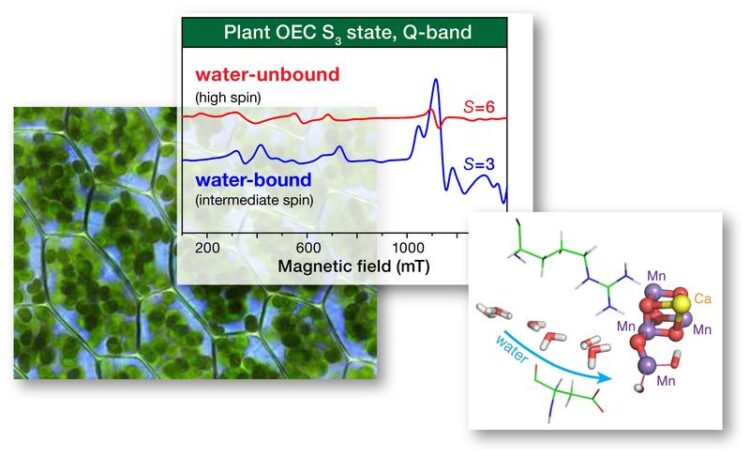Discovery of a new catalytic intermediate in biological water oxidation

EPR-Spektroskopie und quantenchemische Untersuchung des Wasseroxidationskatalysators der biologischen Photosynthese
Dr. Dimitrios Pantazis, MPI für Kohlenforschung
Computational simulations performed by the Pantazis group combined with spectroscopic studies led to the discovery of a new catalytic intermediate in water oxidation.
One of the greatest ambitions of modern chemistry is to reproduce with synthetic catalysts the remarkable feat of water oxidation performed in nature by photosynthetic organisms. Plants use sunlight to split water into oxygen, protons, and electrons. This is the source of the oxygen that we breathe, while the protons and electrons are used in the enzymatic reactions that incorporate atmospheric carbon dioxide into biomolecules. Despite decades of dedicated research efforts, many details of nature’s process remain shrouded in mystery. Very recently, a significant step towards deciphering the mechanism of water oxidation by plants was made by an international team of researchers led by Dr. Dimitrios Pantazis, group leader at the Max-Planck-Institut für Kohlenforschung.
Guided by spectroscopic studies and computational simulations performed by the Pantazis group during the past few years, the research team designed a series of experiments that intended to inhibit the binding of water at the active site of the enzyme responsible for water oxidation, Photosystem II.
Using methanol as an inhibitor to block a protein channel that delivers water to the catalytic site, it was possible to isolate and study a previously unknown form of the catalyst, the intermediate that is responsible for binding and activating the water molecule for subsequent oxidation. Using electron paramagnetic resonance (EPR) spectroscopy in combination with advanced quantum chemical techniques, this previously unknown intermediate state was shown to contain a manganese ion with a very unusual coordination geometry that has no exact precedence in synthetic chemistry.
This manganese ion has only five instead of the normal six ligands and this creates an important free coordination site where water can bind. The discovery of the new catalytic intermediate makes it necessary to reconsider the hypothetical reaction mechanisms discussed so far for water oxidation in plants, but it also has important implications for the design and operational principles of artificial water splitting systems.
The study is published as a “Hot Paper” in the prestigious journal Angewandte Chemie.
Wissenschaftliche Ansprechpartner:
Dr. Dimitrios Pantazis, Group Leader at the Max-Planck-Institut für Kohlenforschung
Phone: +49 208 306 2156
Originalpublikation:
G. Zahariou, N. Ioannidis, Y. Sanakis, D. A. Pantazis. “Arrested Substrate Binding Resolves Catalytic Intermediates in Higher‐Plant Water Oxidation”, Angewandte Chemie International Edition. https://onlinelibrary.wiley.com/doi/10.1002/anie.202012304
Media Contact
All latest news from the category: Life Sciences and Chemistry
Articles and reports from the Life Sciences and chemistry area deal with applied and basic research into modern biology, chemistry and human medicine.
Valuable information can be found on a range of life sciences fields including bacteriology, biochemistry, bionics, bioinformatics, biophysics, biotechnology, genetics, geobotany, human biology, marine biology, microbiology, molecular biology, cellular biology, zoology, bioinorganic chemistry, microchemistry and environmental chemistry.
Newest articles

Innovative 3D printed scaffolds offer new hope for bone healing
Researchers at the Institute for Bioengineering of Catalonia have developed novel 3D printed PLA-CaP scaffolds that promote blood vessel formation, ensuring better healing and regeneration of bone tissue. Bone is…

The surprising role of gut infection in Alzheimer’s disease
ASU- and Banner Alzheimer’s Institute-led study implicates link between a common virus and the disease, which travels from the gut to the brain and may be a target for antiviral…

Molecular gardening: New enzymes discovered for protein modification pruning
How deubiquitinases USP53 and USP54 cleave long polyubiquitin chains and how the former is linked to liver disease in children. Deubiquitinases (DUBs) are enzymes used by cells to trim protein…



